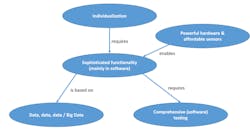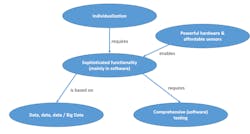Megatrends such as Smart Industry, Industrial Internet of Things (IIoT) and Industry 4.0 are changing current business concepts within the industrial world. What are the underlying trends that are causing this fourth industrial revolution? And what impact will they have on industry’s changing landscape; many companies could go out of business, providing others the chance to build on these trends and introduce new business models. The following five trends have significant importance within our rapidly changing industrial environment.
The Industrial Internet of Things could cause many companies to go out of business, providing others the chance to build on these five interconnected trends and introduce new business models.
Trend 1: Individualization
Henry Ford stated that his customers could have any car color as long as it was black. This would be impossible to consider in today’s world. Mass customization and the demand for individually configured products have led to lot-size-of-one production and increasingly sophisticated requirements on production machines and assembly lines.
ALSO READ: How machine builders can prepare for the IIoT
Trend 2: Powerful hardware and affordable sensors
In parallel, we see that automation hardware has become more powerful, while remaining at the same price level. A modern PLC can run sophisticated control algorithms and process advanced data signals in real time, which would not have been possible 10 years ago. The first multi-core processors on PLCs are already in production use. Also, intelligent sensors have become so affordable that machine builders now integrate them in places it was economically impossible to a few years ago.
Trend 3: Sophisticated functionality (mainly in software)
The boost in hardware performance allows for more sophisticated machine functionality, mainly implemented in real-time software on PLCs and embedded controllers, where, in the past, simple logical operations were performed. This advanced functionality is necessary to provide the flexibility needed for individualization during the production process. Production equipment has a lifespan of more than 20 years. During this time, these systems are rarely modified in order to avoid production loss; reconfiguration of individual machine modules is always a risky task. Digitalization helps to establish a software platform and numerous functional modules, all implemented in software. Over the lifespan of production machines, the individual modules most likely change entirely, while the mechanical skeleton stays the same. This is not a completely new concept; smart phones demonstrate how software is defining and changing a mechatronic system’s behavior.
[javascriptSnippet ]
Trend 4: Data, data, data
Whether data is the “oil of the future” or not is still debatable. However, data clearly is the fuel of algorithms. Advanced functions for predictive maintenance, for instance, need data in order to operate. The abundance of affordable sensor systems―and as a consequence, measured data―on modern production lines is key for running sophisticated functionality on a real-time system. In combination with increasingly powerful processor hardware capable of running powerful algorithms, for instance, machine learning or deep learning, data is the foundation of the ongoing industrial transformation.
Trend 5: Comprehensive (software) testing
Last but not least, advanced functionality requires comprehensive testing to avoid errors and costly service engineering in the field. While machine builders and industrial equipment suppliers have a long history of developing and testing mechanical structures and electronic components, software design is entirely new to a majority of them. Methods for early testing through simulation and virtual commissioning are becoming more popular and necessary.
About the Author
Philipp H. F. Wallner
MathWorks

Leaders relevant to this article:


